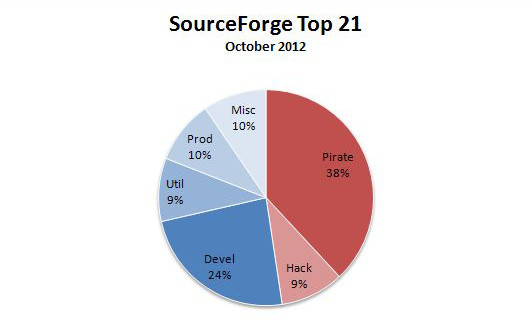The State of SourceForge
2012-11-15
Where would the free software movement be without SourceForge? SourceForge is part of the foundation stone of the free software movement, it importance rivals the Free Software Foundation (FSF). Where FSF provided ideology SourceForge provided infrastructure. (Did anybody actually use Savannah?)

But in recent years SourceForge has lost in relevance, because of how rigid it operates and many projects moved to github. Likewise the FSF lost on relevance, people do not care that much about ideology, they want to get a job done and free software / open source one tool of many. Github is great, because they do not care if your project is properly covered by a OSI approved license and you can create a project on a whim, even private projects.
I stopped using SourceForge when I let my projects wither and die almost a decade ago. But I still have an account there and receive their monthly newsletter. I seldom really read the newsletter, but on a whim I read the last one. The top 20 active projects stuck me as odd.
Here is the list of the 20 most active projects on SourceForge:
- Ares Galaxy (a Bittorrent Client)
- Azureus / Vuze (a Bittorrent Client)
- DeSmuME (a Nintendo DS emulator)
- Classic Shell (a Windows start menu replacement)
- KompoZer (a HTML editor)
- SABnzbdPlus (a usenet mass downloader)
- FreeNAS (a NAS server software)
- UltraDefrag (a defag utility)
- 4k Download (a youtube downloader)
- Rigs of Rods (a physic simulator)
- Orwell Dev-C++ (an IDE)
- StarUML (a UML chart tool)
- LOIC (a denial of service tool)
- cm10i9100vsync (an Android ROM distro)
- eNotes (a note taking tool)
- eMule Plus: e (an eMule client)
- DreaMule (an eMule client)
- SugarCRM (the leading CRM tool)
- PyQt (python binding to QT)
- pseint (a programing learning tool, Spanish)
- Network Spoofer (a WiFi phising tool)
(Actually 21, SourceForge apparently can not count. Yay, zero based lists....)
Is it just me or is the number of piracy and hacking tools disproportionately large? Well I took the time do draw up a chart:

As a full disclosure I came to the values by categorizing as follows:
- Pirate: Ares Galaxy, Azureus, DeSmuME, SABnzbdPlus, 4k Download, cm10i9100vsync, eMule Plus: e, DreaMule
- Hack: LOIC, Network Spoofer
- Development: KompoZer, Orwell Dev-C++, StarUML, PyQt, pseint
- Utility: Classic Shell, UltraDefrag
- Productivity: eNotes, SugarCRM
- Misc: FreeNAS, Rigs of Rods
I accept any critique, that there are legitimate uses for Bittorrent, a Nintendo DS emulator or LOIC. But then I want to remind you that all software in the Pirate and Hack category was developed for that purpose. It turned out that the technological problems people solved for piracy and hacking created technology that is very efficient and useful for content distribution and penetration tests. (Trust me, I was around when some of this was developed... ^_^)
"Dual use" software was always a part of free software, simply because that was almost the only way this software could be developed (or go the Nabster way). Nevertheless, that a little below half of all projects are "dual use" on that list strikes me as odd and definitely not representative of free software as a whole. I think it reflects the current state of SourceForge, a setting star in the free software sky.
In that list are only four projects that I consider strong free software projects:
- Classic Shell
- FreeNAS
- StarUML
- SugarCRM
If my recollection is correct, this used not to be the case. The top project list used to be populated by projects that you knew with few odd unknowns. Many of the currently big free software projects either migrated away from SourceForge or never started by using SourceForge. The landscape has changed since they heydays of the 90s where you did not have a free software project if is was not hosted at SourceForge (or RMS in the AUTHORS.txt).
SourceForge is like an old faithful dog, you can see that it is getting old. It pains you to see it in decline. But I don not think it time to bring it to the vet, just yet.